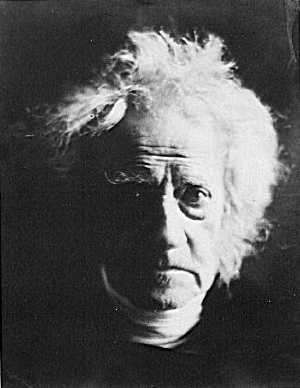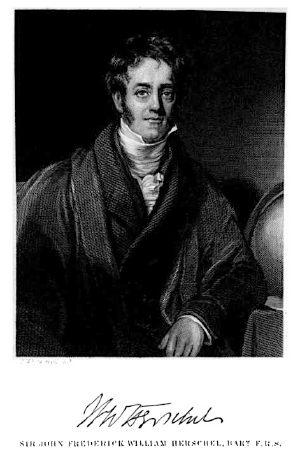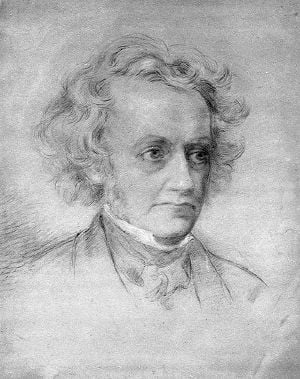Encyclopedia, Difference between revisions of "John Herschel" - New World
Peter Duveen (talk | contribs) |
Peter Duveen (talk | contribs) |
||
| Line 16: | Line 16: | ||
Going to the cape to observe the southern hemisphere | Going to the cape to observe the southern hemisphere | ||
Book about astronomy - very popular | Book about astronomy - very popular | ||
| − | Photography - sodium thiosulphate fixative, and positive and negative, paper photograph. | + | Photography - sodium thiosulphate fixative (dissolved silver nitrate), 1819, and positive and negative, paper photograph. |
| + | 1822 - optics paper acrhomatics. | ||
Left handed and right handed xtals | Left handed and right handed xtals | ||
| − | 1829-tour of europe with charles babbage | + | 1829-tour of europe with charles babbage, met alexander von Humboldt, also toured 1821-22,24 |
| + | |||
| + | 1825-33 astronomical observations in 1825, he decided to study nebulae, indicating that "nobody else could see them." More than 2300 nebulae and star clusters. 1826, two papers on andromeda and Orion Nebula, and began double star catalog, about 5000 objects, compared to 850 of his father. | ||
Herschel was born in [[Slough]], [[Buckinghamshire]], the son of William and Mary Herschel. Herschel's father was a world-famous astronomer who had discovered the planet Uranus in 1881, and would continue to make many contributions to astronomy and physics until his death in _______. When Herschel was seven, he was briefly enrolled at a boarding school at Eaton, but his mother feared the rough treatment he endured there at the hands of the students. He was later placed in a local school, where he made more progress, particularly in languages, although he lagged somewhat in mathematics, not demonstrating an innate proficiency in the subject at that early age. He later studied at [[Eton College]] and [[St John's College, Cambridge]]. | Herschel was born in [[Slough]], [[Buckinghamshire]], the son of William and Mary Herschel. Herschel's father was a world-famous astronomer who had discovered the planet Uranus in 1881, and would continue to make many contributions to astronomy and physics until his death in _______. When Herschel was seven, he was briefly enrolled at a boarding school at Eaton, but his mother feared the rough treatment he endured there at the hands of the students. He was later placed in a local school, where he made more progress, particularly in languages, although he lagged somewhat in mathematics, not demonstrating an innate proficiency in the subject at that early age. He later studied at [[Eton College]] and [[St John's College, Cambridge]]. | ||
| − | He graduated as senior [[Wrangler (University of Cambridge)|wrangler]] in 1813.<ref name=HersNAH/> It was during his time as an undergraduate, that he became friends with [[Charles Babbage]] and [[George Peacock]].<ref name=HersNAH/> | + | He graduated as senior [[Wrangler (University of Cambridge)|wrangler]] in 1813.<ref name=HersNAH/> It was during his time as an undergraduate, that he became friends with [[Charles Babbage]] and [[George Peacock]].<ref name=HersNAH/> In 1816, he became a fellow of the Royal Society of London after submitting a mathematics memoir. That same year, he took up astronomy, building a reflecting telescope with a mirror 18 inches in diameter and with a 20-foot focal length. His interest in Astronomy was said to have been inspired by the optical studies of Wollaston and David Brewster. In 1819, he reported discovering sodium thiosulphate and its ability to dissolve silver salts. This property would later be used in photography to fix photographic plates. Between 1821 and 1823 he re-examined, with [[James South]], the double stars catalogued by his father. For this work he was presented in 1826 with the [[Gold Medal of the Royal Astronomical Society]] (which he won again in 1836), and with the [[Lalande Medal]] of the [[French Institute]] in 1825, while in 1821 the [[Royal Society]] bestowed upon him the [[Copley Medal]] for his mathematical contributions to their Transactions. He was made a Knight of the [[Royal Guelphic Order]] in 1831.<ref name=HersNAH/> |
==Visit to South Africa == | ==Visit to South Africa == | ||
| − | In 1833 Herschel | + | In 1833, the death of his mother and the decline of British science prompted Herschel to embark on a journey to South Africa to observe and catalog the stars and other celestial objects obvervable only from the Southern Hemisphere. <ref name=HersNAH/> This was to be a completion as well as extension of the survey of the northern heavens undertaken initially by his father [[William Herschel]]. He arrived in [[Cape Town]] on 15 January [[1834 in South Africa|1834]]. Amongst his other observations during this time was that of the return of [[Comet Halley]]. |
However, in addition to his astronomical work, this voyage to a far corner of the British empire also gave Herschel an escape from the pressures under which he found himself in London, where he was one of the most sought-after of all British men of science. While in southern Africa, he engaged in a broad variety of scientific pursuits free from a sense of strong obligations to a larger scientific community. It was, he later recalled, probably the happiest time in his life. | However, in addition to his astronomical work, this voyage to a far corner of the British empire also gave Herschel an escape from the pressures under which he found himself in London, where he was one of the most sought-after of all British men of science. While in southern Africa, he engaged in a broad variety of scientific pursuits free from a sense of strong obligations to a larger scientific community. It was, he later recalled, probably the happiest time in his life. | ||
Revision as of 06:41, 17 July 2007


Sir John Frederick William Herschel, 1st Baronet KH (March 7, 1792–May 11, 1871) was an English mathematician, astronomer, chemist, and experimental photographer/inventor. He was the son of astronomer William Herschel and the father of 12 children.[2]
Herschel originated the use of the Julian day system in astronomy. He named seven moons of Saturn and four moons of Uranus. He made many contributions to the science of photography, and investigated color blindness and the chemical power of ultraviolet rays.
Early life and work on astronomy
first mathematical paper mathematics club:babbage and others astronomy - the scientist who encouraged him Map of the stars: completing his father's work, building telescopes Going to the cape to observe the southern hemisphere Book about astronomy - very popular Photography - sodium thiosulphate fixative (dissolved silver nitrate), 1819, and positive and negative, paper photograph. 1822 - optics paper acrhomatics. Left handed and right handed xtals 1829-tour of europe with charles babbage, met alexander von Humboldt, also toured 1821-22,24
1825-33 astronomical observations in 1825, he decided to study nebulae, indicating that "nobody else could see them." More than 2300 nebulae and star clusters. 1826, two papers on andromeda and Orion Nebula, and began double star catalog, about 5000 objects, compared to 850 of his father.
Herschel was born in Slough, Buckinghamshire, the son of William and Mary Herschel. Herschel's father was a world-famous astronomer who had discovered the planet Uranus in 1881, and would continue to make many contributions to astronomy and physics until his death in _______. When Herschel was seven, he was briefly enrolled at a boarding school at Eaton, but his mother feared the rough treatment he endured there at the hands of the students. He was later placed in a local school, where he made more progress, particularly in languages, although he lagged somewhat in mathematics, not demonstrating an innate proficiency in the subject at that early age. He later studied at Eton College and St John's College, Cambridge. He graduated as senior wrangler in 1813.[2] It was during his time as an undergraduate, that he became friends with Charles Babbage and George Peacock.[2] In 1816, he became a fellow of the Royal Society of London after submitting a mathematics memoir. That same year, he took up astronomy, building a reflecting telescope with a mirror 18 inches in diameter and with a 20-foot focal length. His interest in Astronomy was said to have been inspired by the optical studies of Wollaston and David Brewster. In 1819, he reported discovering sodium thiosulphate and its ability to dissolve silver salts. This property would later be used in photography to fix photographic plates. Between 1821 and 1823 he re-examined, with James South, the double stars catalogued by his father. For this work he was presented in 1826 with the Gold Medal of the Royal Astronomical Society (which he won again in 1836), and with the Lalande Medal of the French Institute in 1825, while in 1821 the Royal Society bestowed upon him the Copley Medal for his mathematical contributions to their Transactions. He was made a Knight of the Royal Guelphic Order in 1831.[2]
Visit to South Africa
In 1833, the death of his mother and the decline of British science prompted Herschel to embark on a journey to South Africa to observe and catalog the stars and other celestial objects obvervable only from the Southern Hemisphere. [2] This was to be a completion as well as extension of the survey of the northern heavens undertaken initially by his father William Herschel. He arrived in Cape Town on 15 January 1834. Amongst his other observations during this time was that of the return of Comet Halley.
However, in addition to his astronomical work, this voyage to a far corner of the British empire also gave Herschel an escape from the pressures under which he found himself in London, where he was one of the most sought-after of all British men of science. While in southern Africa, he engaged in a broad variety of scientific pursuits free from a sense of strong obligations to a larger scientific community. It was, he later recalled, probably the happiest time in his life.
Gradualist view of development
Intrigued by the ideas of gradual formation of landscapes set out in Charles Lyell's Principles of Geology, he wrote to Lyell commenting and urging a search for natural laws underlying the "mystery of mysteries" of how species formed, prefacing his words with the couplet:
- He that on such quest would go must know not fear or failing
- To coward soul or faithless heart the search were unavailing.
Taking a gradualist view of development, he commented
- "Time! Time! Time! — we must not impugn the Scripture Chronology, but we must interpret it in accordance with whatever shall appear on fair enquiry to be the truth for there cannot be two truths. And really there is scope enough: for the lives of the Patriarchs may as reasonably be extended to 5000 or 50000 years apiece as the days of Creation to as many thousand millions of years."
The document was circulated, and Charles Babbage incorporated extracts in his ninth and unofficial Bridgewater Treatise, which postulated laws set up by a divine programmer. When HMS Beagle called at Cape Town, Captain Robert FitzRoy and the young naturalist Charles Darwin visited Herschel on 3 June 1836. Later on, Darwin would be influenced by Herschel's writings in developing his theory advanced in The Origin of Species. In the opening lines of that work, Darwin writes that his intent is "to throw some light on the origin of species — that mystery of mysteries, as it has been called by one of our greatest philosophers," referring to Herschel.
Return to England
Herschel returned to England in 1838, was created a baronet[2] and published Results of Astronomical Observations made at the Cape of Good Hope in 1847. In this publication he proposed the names still used today for the seven then-known satellites of Saturn: Mimas, Enceladus, Tethys, Dione, Rhea, Titan, and Iapetus.[3] In the same year, Herschel received his second Copley Medal from the Royal Society for this work. A few years later, in 1852, he proposed the names still used today for the four then-known satellites of Uranus: Ariel, Umbriel, Titania, and Oberon.
Photography
Herschel made numerous contributions to photography. He made improvements in photographic processes, particularly in inventing the cyanotype process and variations, the precursors of the modern blueprint process. He experimented with color reproduction, noting that rays of different parts of the spectrum tended to impart their own color to a photographic paper.
He coined the term photography and applied the terms negative and positive to photography.[2]
He discovered sodium thiosulfate to be a solvent of silver halides in 1819, and informed Talbot and Daguerre of his discovery that this "hyposulphite of soda" ("hypo") could be used as a photographic fixer, to "fix" pictures and make them permanent, after experimentally applying it thus in 1839.
General
Herschel wrote many papers and articles, including entries on meteorology, physical geography, and the telescope from the eighth edition of the Encyclopædia Britannica.[2]
In 1835, the New York Sun newspaper wrote a series of satiric articles that came to be known as the Great Moon Hoax, with statements falsely attributed to Herschel about his supposed discoveries of animals living on the Moon, including batlike winged humanoids.
Herschel Island (in the Arctic Ocean, north of the Yukon Territory) and J. Herschel crater, on the Moon, are named after him.
Family
He married Margaret Brodie Stewart (1810-1864) on 3 March 1829. They had 12 children:
- Caroline Emilia Mary Herschel (1830-1909)
- Isabella Herschel (1831-1893)
- Sir William James Herschel, 2nd Bt. (1833-1917)
- Margaret Louisa Herschel (1834-1861), an accomplished artist
- Alexander Stewart Herschel (1836-1907)
- Colonel John Herschel (1837-1921)
- Maria Sophie Herschel (1839-1929)
- Amelia Herschel (1841-1926) married Sir Thomas Francis Wade, diplomat and sinologist
- Julia Mary Herschel (1842-1933)
- Matilda Rose Herschel (1844-1914)
- Francisca Herschel (1846-1932)
- Constance Ann Herschel (1855-1939)
On his death at Collingwood, his home near Hawkhurst in Kent, he was given a national funeral and buried in Westminster Abbey.
Publications
- On the Aberration of Compound Lenses and Object-Glasses (1821);[2]
- Outlines of Astronomy (1849);[2]
- General Catalogue of 10,300 Multiple and Double Stars (published posthumously);
- Familiar Lectures on Scientific Subjects;
- General Catalogue of Nebulae and Clusters;
- Manual of Scientific Inquiry (ed.), (1849);[2]
- Familiar Lectures on Scientific Subjects (1867).[2]
See also
Notes
- ↑ John Timbs, The Year-book of Facts in Science and Art, London: Simpkin, Marshall, and Co., 1846
- ↑ 2.00 2.01 2.02 2.03 2.04 2.05 2.06 2.07 2.08 2.09 2.10 2.11 Herschel, Sir John Frederick William, 1792-1871, astronomer NAHSTE project, University of Edinburgh. Retrieved June 22, 2007.
- ↑ "Monthly Notices of the Royal Astronomical Society, volume 8, page 42" (archive), NASA, 2004, ADsabs.harvard.edu webpage: Adsabs-MNRAS.
ReferencesISBN links support NWE through referral fees
<<We need at least 3 references here, properly formatted.>>
External links
- http://www-groups.dcs.st-and.ac.uk/~history/Mathematicians/Herschel.html
- Biography: JRASC 74 (1980) 203
- The Herschel Chronicle
- Photographic Process and Early Photograms
Credits
New World Encyclopedia writers and editors rewrote and completed the Wikipedia article in accordance with New World Encyclopedia standards. This article abides by terms of the Creative Commons CC-by-sa 3.0 License (CC-by-sa), which may be used and disseminated with proper attribution. Credit is due under the terms of this license that can reference both the New World Encyclopedia contributors and the selfless volunteer contributors of the Wikimedia Foundation. To cite this article click here for a list of acceptable citing formats.The history of earlier contributions by wikipedians is accessible to researchers here:
The history of this article since it was imported to New World Encyclopedia:
Note: Some restrictions may apply to use of individual images which are separately licensed.
